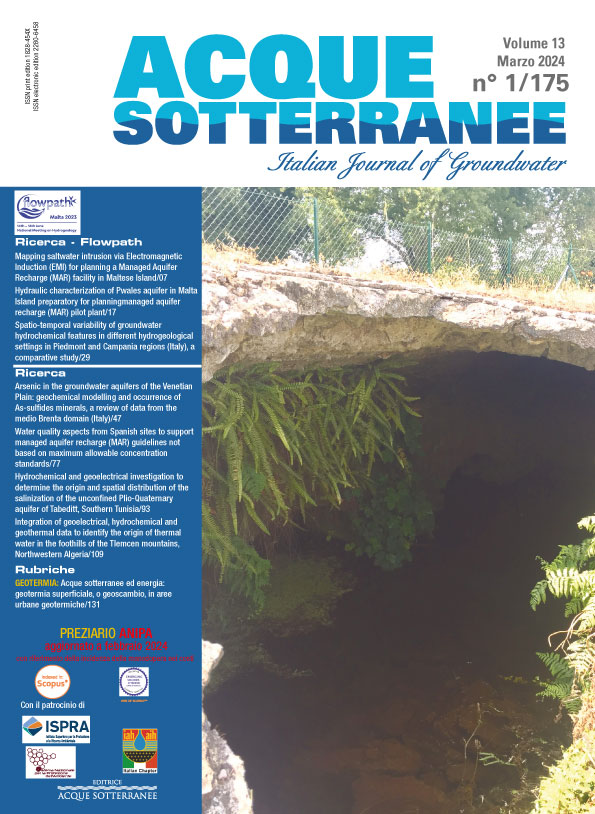Spatio-temporal variability of groundwater hydrochemical features in different hydrogeological settings in Piedmont and Campania regions (Italy), a comparative study
SUPPLEMENTARY MATERIALS: 108
All claims expressed in this article are solely those of the authors and do not necessarily represent those of their affiliated organizations, or those of the publisher, the editors and the reviewers. Any product that may be evaluated in this article or claim that may be made by its manufacturer is not guaranteed or endorsed by the publisher.
Authors
The spatio-temporal evolution of groundwater chemistry has seen an increase in interest over the last decade at a global level. Identifying and discerning the sources of the natural and anthropogenic compounds and the actual hydrochemical processes, as well as their evolution, is essential to support a sustainable planning for managing and protecting groundwater resources at the present time and in the future. The main objective of this study is the comparison of two study areas in Italy (Piedmont and Campania Regions), different in their geographical and geological contexts and climate conditions, to highlight the similarities and differences in the hydrogeochemical behavior in space and time. Three main ions were considered (NO3 –, SO4 2–, Na+) and analyzed to identify the sources and hydrochemical processes responsible for their spatial distribution in the 2015-2020 period and evaluate the existence and the potential causes of trends in their concentration for the 2000-2020 period. Results highlight specific factors and processes distinguishing the spatial distribution and temporal variability of ion concentrations in Piedmont and Campania study areas. These processes are mainly related to the geological and geographical features of the study areas. In both areas, a significant influence of anthropogenic pressures emerges for both spatial and temporal evolutions, with remarkably increasing trends in NO3 – concentrations. In conclusion, some factors and processes emerge as site-specific, mainly related to the geological aspects and natural hydrochemical processes, whereas others are in common (i.e., anthropogenic impacts); thus, reinforcing the advantage of making comparative studies.
How to Cite

This work is licensed under a Creative Commons Attribution-NonCommercial 4.0 International License.
PAGEPress has chosen to apply the Creative Commons Attribution NonCommercial 4.0 International License (CC BY-NC 4.0) to all manuscripts to be published.
Similar Articles
- Giovanni Conte, Pio Di Manna, Rossella Maria Gafà, Lucio Martarelli, Gennaro Maria Monti, Marco Amanti, Sustainable yield of the Colle Quartara carbonate aquifer in the Southern Lepini Mountains (Central Italy) , Acque Sotterranee - Italian Journal of Groundwater: Vol. 5 No. 3 (2016)
- Valentina Vincenzi, Leonardo Piccinini, Alessandro Gargini, Michele Sapigni, Parametric and numerical modeling tools to forecast hydrogeological impacts of a tunnel , Acque Sotterranee - Italian Journal of Groundwater: Vol. 11 No. 1 (2022)
- Maria Rosaria Alfio, Gabriella Balacco, Vittoria Dragone, Maurizio Polemio, A statistical approach for describing coastal karst aquifer: the case of the Salento aquifer (Southern Italy) , Acque Sotterranee - Italian Journal of Groundwater: Vol. 13 No. 4 (2024)
- Francesca Lotti, Antonella Baiocchi, Salvatore D'Onofrio, Vincenzo Piscopo, Hydrogeological site characterization of marly-silici-calcareous rocks through surveys of discontinuities and pumping tests , Acque Sotterranee - Italian Journal of Groundwater: Vol. 1 No. 1 (2012)
- Behailu Birhanu, Seifu Kebede, Marco Masetti, Tenalem Ayenew, WEAP-MODFLOW dynamic modeling approach to evaluate surface water and groundwater supply sources of Addis Ababa city , Acque Sotterranee - Italian Journal of Groundwater: Vol. 7 No. 2 (2018)
- Lucio Di Matteo, Simona Menegon, Augusto Rossi, Stefano Liti, Understanding karst environments by thermo-hygrometric monitoring: preliminary results from the Cesi Mountain karst system (Central Italy) , Acque Sotterranee - Italian Journal of Groundwater: Vol. 5 No. 1 (2016)
- Fabio Tateo, Paolo Fabbri, Maria Chiara Dalconi, Luca Peruzzo, Arsenic in the groundwater aquifers of the Venetian Plain: geochemical modelling and occurrence of As-sulfides minerals, a review of data from the medio Brenta domain (Italy) , Acque Sotterranee - Italian Journal of Groundwater: Vol. 13 No. 1 (2024)
- Stefano Bernardinetti, Stefano Maraio, Pier Paolo Gennaro Bruno, Valentina Cicala, Serena Minucci, Miriana Giannuzzi, Marilena Trotta, Francesco Curedda, Simone Febo, Matteo Vacca, Enrico Guastaldi, Tommaso Colonna, Filippo Bonciani, Emanuele Tufarolo, Fabio Brogna, Andrea Zirulia, Omar Milighetti, Potential shallow aquifers characterization through an integrated geophysical method: multivariate approach by means of k-means algorithms , Acque Sotterranee - Italian Journal of Groundwater: Vol. 6 No. 2 (2017)
- Davide Fronzi, Mattia Gaiolini, Elisa Mammoliti, Nicolò Colombani, Stefano Palpacelli, Mirco Marcellini, Alberto Tazioli, Groundwater-surface water interaction revealed by meteorological trends and groundwater fluctuations on stream water level , Acque Sotterranee - Italian Journal of Groundwater: Vol. 11 No. 2 (2022)
- Mara Meggiorin, Giulia Passadore, Silvia Bertoldo, Andrea Sottani, Andrea Rinaldo, Stochastic analysis of groundwater temperature timeseries for characterizing check dams efficiency: case study on a Managed Aquifer Recharge site (Veneto, Italy) , Acque Sotterranee - Italian Journal of Groundwater: Vol. 8 No. 4 (2019)
You may also start an advanced similarity search for this article.








